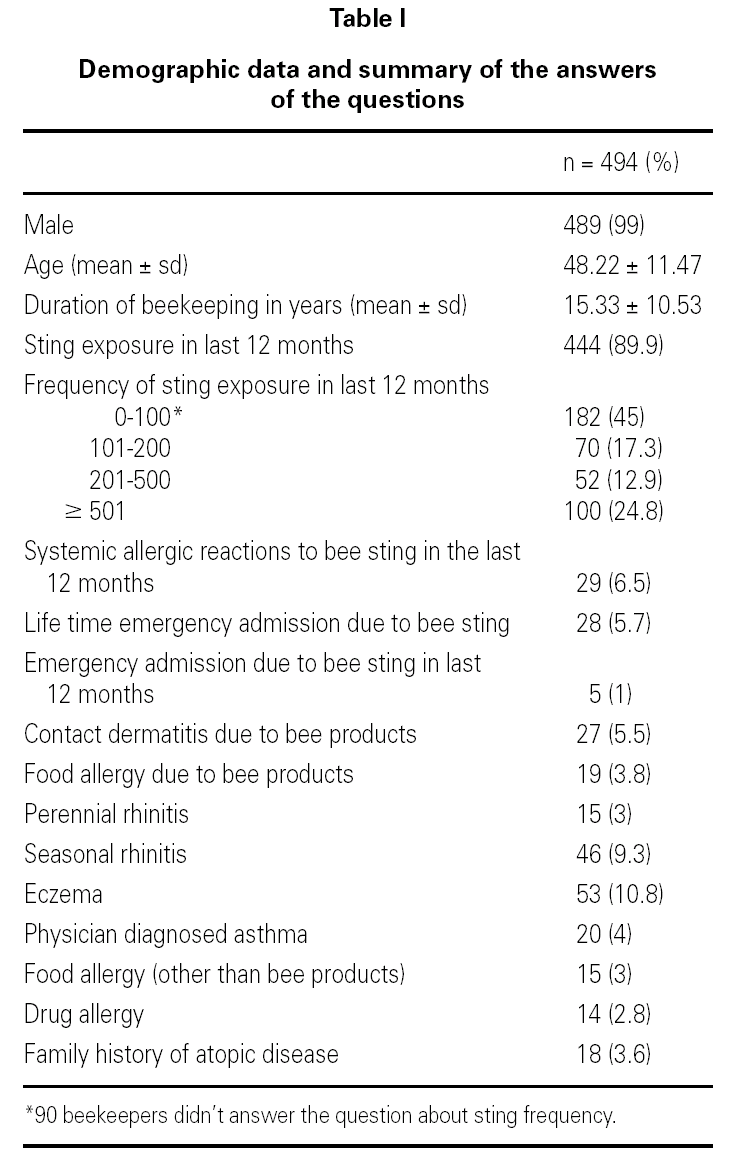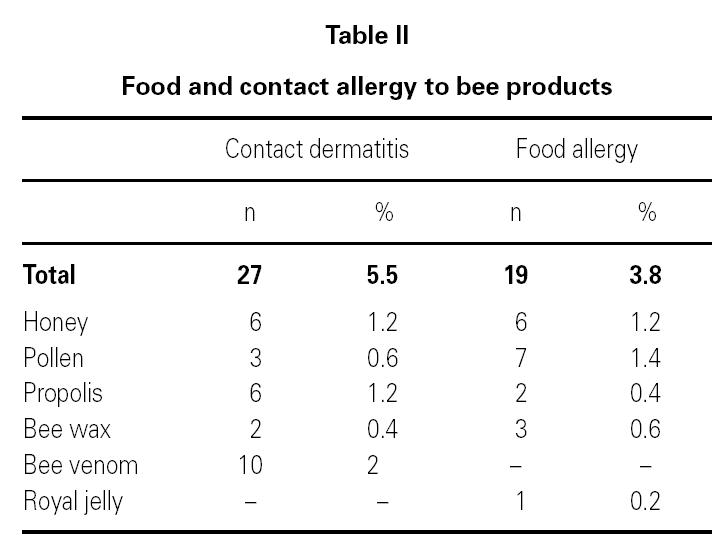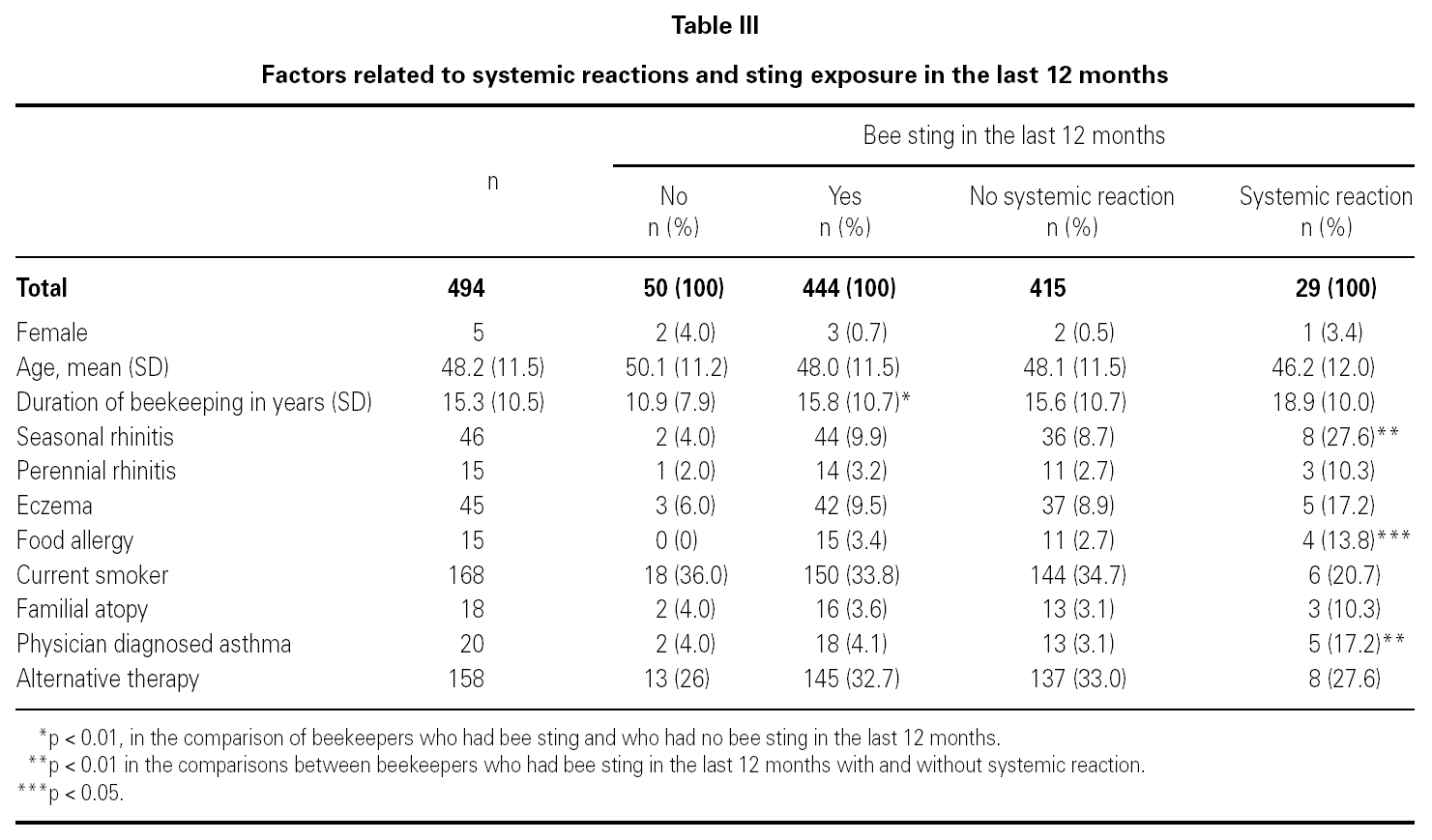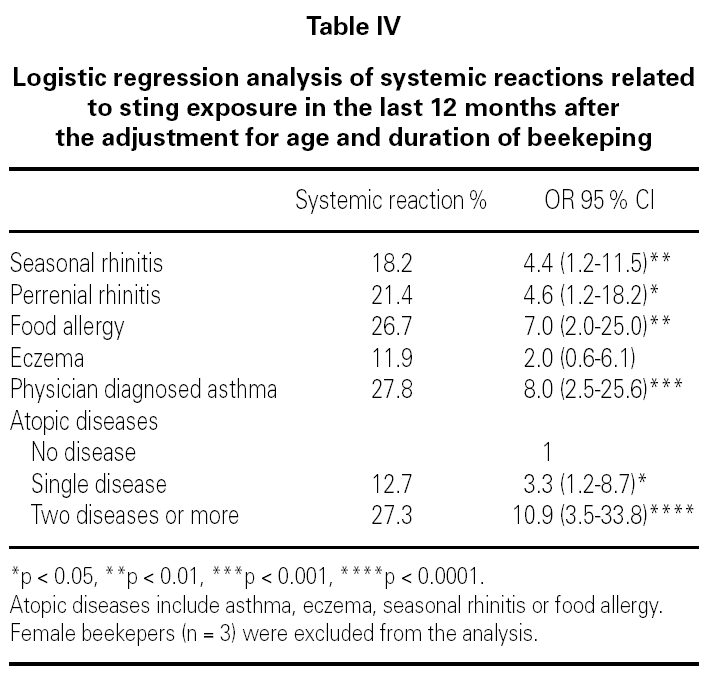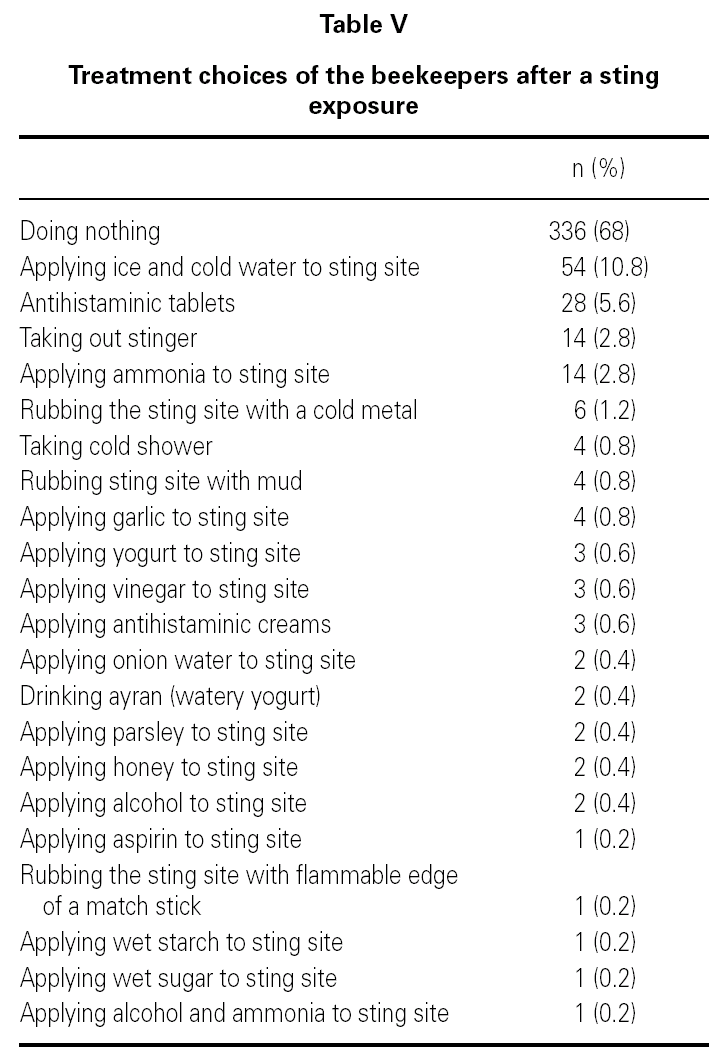INTRODUCTION
Beekeeping, known as the cheapest and easiest way of employment in agricultural area, is very important for some developing countries. Beekeeping and honey production have been progressing as profitable occupations in recent years in Turkey as well. In the last ten years, the total number of beehives and honey production has increased twice and Turkey is the 4th in this area with 4,000,000 beehives producing 63,000 tons of honey 1.
As the number of beekeepers increases in Turkey, problems related to bee and wasp stings exposure, involve the beekeepers to an increasing extent. As expected, beekeepers are more susceptible to sting exposure than the general population. Although systemic reactions following bee stings have been found to be 14 % to 42 % in beekeepers 2-4, it is only 0.8 % to 3.3 % in general population 5-7. The prevalence of atopy in beekeepers varies from 20 % to 48 % 2,8-12.
Since there is no previous medical data about beekeepers in Turkey, we designed this study to evaluate the prevalence and types of sting reactions, concurrent atopic diseases, risk factors for systemic reactions and self treatment choices for bee sting among Turkish beekeepers.
METHODS
Hacettepe University Bee and Bee Products Application and Research Center (HARUM) arranged educational meetings in seven different cities of Turkey including Ankara, Mersin, Mugla, Canakkale, Yalova, Balikesir and Zonguldak to improve the knowledge and skills about beekeeping of beekeepers between December 2004 and June 2005. After these meetings, a self administered questionnaire, including questions about demographic data, history of bee stings, type of reactions, emergency admissions in the last 12 months, concurrent atopic and nonatopic diseases, smoking status, self treatment tendencies, drug and food allergies, were distributed to beekeepers to be completed. Subjects were told to answer "no" if they were not sure about the answer.
In every city, between 100-350 with a total of 1245 beekeepers attended these meetings and 494 (39.6 %) of them returned the questionnaires.
Statistics
Association between factors and bee sting in the last 12 months and systemic reaction due to bee sting in the last 12 months were tested by Chi-square testing. Fisher's exact test was used when the expected cell count was below 5. Independent association between systemic reaction due to bee sting in the last 12 months and potential risk factors were assessed via logistic regression analysis after the adjustment for age and duration of beekeeping. P value less than 0.05 was considered for statistical significance.
RESULTS
Four hundred ninety four subjects who completed the questionnaire were enrolled to the study. Four hundred eighty nine (99 %) were males and five were females, with a mean age of 48.2 ± 11.5. They have been beekeeping for a mean time of 15.3 ± 10.5 years. There were 444 subjects (89.9 %) with a history of sting exposure in the last 12 months while 50 subjects (10.1 %) denied such a history. Systemic reactions after bee stings in the last 12 months were present in 29 (6.5 %) subjects, nine of them being anaphylactic reactions. There were 28 (5.7 %) subjects who had history of emergency room admission and only 5 of them occurred in the last 12 months. Demographic data and answers to questions were summarized in table I.
Contact dermatitis due to honey and bee products was present in 27 beekeepers (5.5 %) while food allergy was present in 19 cases (3.8 %) (table II).
Table III outlines the factors related to systemic reactions in beekeepers stung in the last 12 months. Among this group of beekeepers, seasonal rhinitis was reported in 27.6 %, food allergy in 13.8 %, familial atopy in 10.3 % and physician diagnosed asthma in 17.2 %. All these factors were significantly associated with systemic reactions due to bee sting in the last 12 months. Longer duration of beekeeping was significantly associated with higher frequency of bee stings in the last 12 months (p < 0.01) but there was no correlation between the duration of beekeeping and the rate of systemic reactions.
When systemic reactions due to sting exposure was controlled with age and duration of beekeeping in logistic regression model, seasonal rhinitis (OR: 4.4, 95 % CI: 1.2-11.5), perennial rhinitis (OR: 4.6, 95 % CI: 1.2-18.2), food allergy (OR:7.0, 95 % CI: 2.0-25.0) and physician diagnosed asthma (OR: 8.0, 95 %CI: 2.5-25.6) were significantly associated with systemic reactions due to bee sting in the last 12 months. Logistic regression analysis also showed that the risk of systemic reactions increased approximately threefold when only one atopic disease was present and eleven fold when two or more concurrent atopic diseases were present compared to having no atopic disease (table IV).
Smoking habits of beekeepers were also evaluated. There were 168 (34 %) current smokers whose mean beginning age of smoking was 18.2 ± 4.9 while there were 112 ex-smokers (22.6 %) and the mean age to quit smoking was 38.9 ± 10. There was no relation between systemic reactions and smoking status. Treatment choices after sting exposure were shown in table V. Three hundred thirty six of them (68 %) were doing nothing when they were stung. Most frequently used therapy was applying ice and cold water (10.8 %). The ones who were taking antihistaminic tablets were only 5.6 % of them. Highly different complementary treatment modalities were listed in the table V. The frequency of using alternative treatments was not increased in the ones who have experienced systemic reactions (p > 0.5).
DISCUSSION
There are relatively small number of studies about bee sting reactions and clinical symptoms in beekeepers in the English literature and this is the first report from Turkey. This study presents that occurrence of systemic allergic reactions to bee stings is low but the frequency of bee stings in the last 12 months is high in Turkish beekeepers. Systemic reactions to bee sting are significantly associated with seasonal and perennial rhinitis, food allergy and physician diagnosed asthma.
In our study, 6.5 % of beekeepers reported systemic allergic reactions to bee sting. In previous studies, rate of systemic reactions in beekeepers was found to be between 14 % and 42 % 2,3,13. Among risk groups such as forestry workers and cellulose paper factory workers, prevalence of systemic reactions to bee sting was 21 % and 19.9 %, respectively 14,15. When compared to these figures, rate of systemic reactions to bee sting was low in Turkish beekeepers. Bousquet et al 2 claimed that the degree of sensitization of beekeepers against bee sting was strongly related to the annual number of stings and that was why beekeepers in their study that were stung often appeared to be protected against bee stings. They found that 50 stings in a year appeared to be a minimal number for protection and the risk of allergy was nearly absent over 200 stings in a year. It was also reported that the more frequent the bee stings, the fewer clinical symptoms appear 8. Interestingly, in our study, only 10.1 % of beekeepers denied bee sting exposure in the last 12 months while 45 % reported 1-100 times, 17.3 % 100-200 times, 37.7 % more than 200 times of bee stings in a year. This data shows that Turkish beekeepers don't pay attention to protect themselves from bee sting effectively while working at beehives and as a result they spontaneously become desensitized by frequent sting exposure. Another possible mechanism to explain the low rate of systemic reactions might be due to the long period of beekeeping season in Turkey. As hypothesized previously 2, beekeeping all throughout the year in warm regions leads to continuous sting exposure and eventually results in continuous protection to bee stings. However, the gap between working seasons in cold regions such as northern Europe may decrease the protective effect of continuous bee sting and results in higher rate of systemic reactions.
A clinical history of atopic diseases, such as asthma, seasonal rhinitis, eczema and food allergy was present in 15 of beekeepers (51.7 %) that have experienced systemic reaction in their histories. This rate of atopy among beekeepers is similar to results of a study 10 reporting a history of atopy in 47 % of systemic reactors, but higher than some other studies in which rates of atopy were reported between 20 % to 42 % 2,9,12,16. Differences between these figures may be due to different parameters to define atopy such as in vivo tests and clinical history. Having seasonal rhinitis (p < 0.01), physician diagnosed asthma (p < 0.01) and food allergy (p < 0.05) were significantly related to systemic reactions to bee stings. This is in accordance with the studies in which atopy has been shown to predispose to more severe reactions 2,10. When systemic reactions were controlled with age and the duration of beekeeping in logistic regression model, in addition to the previously mentioned factors perennial rhinitis was found to be significantly related with systemic reaction (p < 0.05). Furthermore, the risk of systemic reactions increased approximately threefold when two or more concurrent atopic diseases were present compared to the presence of only one atopic disease. Our results clearly suggest that having atopic clinical disease significantly predispose beekeepers to systemic reactions.
Twenty-seven beekeepers (5.5 %) had a history of contact dermatitis while 19 (3.8 %) of them had food allergy to honey and bee products. Because there is no relevant data in the literature other than case reports of contact dermatitis due to propolis 17, we are unable to make comparisons about these results.
In this study, there was no relation between age, duration of beekeeping and systemic reactions. This data is in accordance with the study reporting that the duration of beekeeping did not influence the symptoms of beekeepers 3. However our results disagree with the findings of some previous studies, which claimed that shorter duration of beekeeping and younger ages of beekeepers were related to higher prevalence of allergic symptoms 8,18. High frequency of sting exposure, even in early years of beekeeping, could once more explain why there is no relation between age or duration of beekeeping and systemic reactions in Turkish beekeepers. Besides, the positive association between the duration of beekeeping and the high prevalence of bee stings in the last 12 months suggests that experienced beekeepers with no systemic reactions did not seem to be afraid of bee stings and thus paid no attention to protect themselves.
Various and interesting self-treatment alternatives were present among beekeepers. Three hundred thirty six (68 %) beekeepers did nothing for treatment when they were stung. Only 14 (2.8 %) subjects knew that they should take out the stinger after a bee sting and 28 (5.6 %) of them were carrying antihistaminic tablets with them. They applied various stuff to sting site such as ammonia, mud, garlic, yogurt, starch, honey, vinegar, cold metal, etc. At countryside in Turkey, it is known that complementary treatments are widely used by villagers not only for bee stings but also for other organic diseases, as well.
The study subjects were selected from 7 cities of Turkey, which were thought to represent all Turkish beekeepers. The large number of subjects (494) included in our study when compared to other studies about beekeepers is the strength of our study.
In conclusion, incidence of systemic reactions in Turkish beekeepers is low due to protective effect of high frequency of bee stings. History of seasonal and perennial rhinitis, food allergy and physician diagnosed asthma is associated with systemic sting reactions. This study indicates that the risk of systemic reaction increases approximately threefold when one atopic disease is present and eleven fold when two or more concurrent atopic diseases are present compared to having no atopic disease.
Acknowledgment
We are grateful to Ahmet Ugur Demir, MD for his assistance in statistical analysis.
Correspondence:
S. Celikel, MD
Hacettepe University. School of Medicine Ankara. Turkey
E-mail: serhatcelikel@hotmail.com
scekujek@gmail.com



